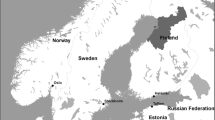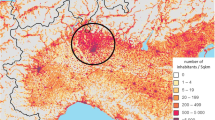Abstract
The social dimension of purchase seems particularly important when it comes to food, since it can contribute to foster “consumers’ embeddedness” in the local food system. The discussion on this topic is growing after the emergence of alternative food networks (AFNs), which are thought to have potentials to re-connect the different actors of local food systems, and/or to strengthen the existing social ties among them. This study focuses on the evaluation of the degree of sociality in different food shopping environments. The research is focused on the structure and the features of the interactions, with the aim to provide an assessment of the degree of sociality of AFNs compared to other food chain networks. More specifically, a farmers’ market, a greengrocer and a supermarket have been compared. The three shopping environments show remarkable differences: in the supermarket perfunctory interactions are most often observed, unless shoppers already know each other, whereas the farmers’ market environment is likely to foster quite intense relations among strangers; the greengrocer, on the contrary, shows a completely different pattern of relations, typically involving customers who already know each other. Results support the common argument that farmers’ markets may enhance sociality among people, although some interesting relations patterns are observed in the other food stores as well. Issues for further research in the field emerge, which might be useful to improve the understanding of the social dimension of food shopping as well as to more deeply analyse the elements of attractiveness of AFNs.




Similar content being viewed by others
Notes
A wider discussion on these topics is provided in the recent paper by the JRC of the European commission “Short Food Supply Chains and Local Food Systems in the EU. A State of Play of their Socio-Economic Characteristics” by Moya Kneafsey, Laura Venn, Ulrich Schmutz, Liz Trenchard, Trish Eyden-Wood, Elizabeth Bos, Gemma Sutton and Matthew Blackett, 2013.
The outputs of the correlations, Chi square and ANOVA analyses cited in the text are shown in “Appendix”.
References
Alkon, A. (2008). Paradise or pavement: The social constructions of the environment in two urban farmers’ markets and their implications for environmental justice and sustainability. Local Environment, 13(3), 271–289.
Arnold, M. J., & Reynolds, K. (2003). Hedonic shopping motivations. Journal of Retailing, 79(2), 77–95.
Babin, B. J., Darden, W. R., & Griffin, M. (1994). Work and/or fun: Measuring hedonic and utilitarian shopping value. Journal of Consumer Research, 20(4), 644–656.
Beckie, M. A., Kennedy, E. H., & Wittman, H. (2012). Scaling up alternative food networks: Farmers’ markets and the role of clustering in western Canada. Agriculture and Human Values, 29(3), 333–345.
Borges, A., Chebat, J. C., & Babin, B. J. (2010). Does a companion always enhance the shopping experience? Journal of Retailing and Consumer Services, 17(4), 294–299.
Campbell, C. (1997). Shopping, pleasure and the sex war. In P. Falk & C. Campbell (Eds.), The shopping experience (pp. 166–176). London: Sage Publications.
Cembalo, L., Migliore, G., & Schifani, G. (2013). Sustainability and new models of consumption: The solidarity purchasing groups in Sicily. Journal of Agricultural and Environmental Ethics, 26(1), 281–303.
Censis & Coldiretti (2010). Le abitudini alimentari degli italiani: L’era del politeismo a tavola. Collana Note e commenti n.7/8. Roma: Centro Studi Investimeni Sociali.
Chaudhuri, A. (2012). Emotion and reason in consumer behaviour. New York: Routledge.
Chebat, J. C., Sirgy, M. J., & St-James, V. (2006). Upscale image transfer from malls to stores: A self-image congruence explanation. Journal of Business Research, 59(12), 1288–1296.
Cramer, L., & Antonides, G. (2011). Endowment effects for hedonic and utilitarian food products. Food Quality and Preference, 22(1), 3–10.
Curry, D. (Ed.) (2002). Farming and food, a sustainable future. London: Report of the Policy Commission on the Future of Farming and Food.
DeLind, L. B., & Bingen, J. (2008). Place and civic culture: Re-thinking the context for local agriculture. Journal of Agricultural and Environmental Ethics, 21, 127–151.
Eden, S., Bear, C., & Walker, G. (2008). Mucky carrots and other proxies: Problematising the knowledge-fix for sustainable and ethical consumption. Geoforum, 39(2), 1044–1057.
Feenstra, G. W. (1997). Local food systems and sustainable communities. American Journal of Alternative Agriculture, 12(1), 28–36.
Feenstra, G. W. (2002). Creating space for sustainable food systems: Lessons from the field. Agriculture and Human Values, 19(2), 99–106.
Feinberg, R. A., Sheffler, B., Meoli, J., & Rummel, A. (1989). There’s something social happening at the mall. Journal of Business and Psychology, 4(1), 49–63.
Fischer, C. S. (1982). To dwell among friends: Personal networks in town and city. Chicago: University of Chicago Press.
Gram, M. (2010). Self-reporting vs. observation: Some cautionary examples from parent/child food shopping behaviour. International Journal of Consumer Studies, 34(4), 394–399.
Granovetter, M. (1985). Economic action and social structure: The problem of embeddedness. American Journal of Sociology, 91(3), 481–510.
Griffin, M. R., & Frongillo, E. A. (2003). Experiences and perspectives of farmers from Upstate New York farmers’ markets. Agriculture and Human Values, 20(2), 189–203.
Grove, S. J., & Fisk, R. P. (1992). Observational data collection methods for services marketing: An overview. Journal of the Academy of Marketing Science, 20(3), 217–224.
Hendrickson, M. K., & Heffernan, W. D. (2002). Opening spaces through relocalisation: Locating potential resistance in the weaknesses of the global food system. Sociologia Ruralis, 42(4), 347–369.
Hinrichs, C. C. (2000). Embeddedness and local food systems: Notes on two types of direct agricultural market. Journal of Rural Studies, 16(3), 295–303.
Hunt, A. R. (2007). Consumer interactions and influences on farmers’ market vendors. Renewable Agriculture and Food Systems, 22(1), 54–66.
Jarosz, L. (2000). Understanding agri-food networks as social relations. Agriculture and Human Values, 17(3), 279–283.
Kirwan, J. (2006). The interpersonal world of direct marketing: Examining conventions of quality at UK farmers’ markets. Journal of Rural Studies, 22(3), 301–312.
Lambert, D. M., & Cooper, M. C. (2000). Issues in supply chain management. Industrial Marketing Management, 29(1), 65–83.
Lyson, T. A. (2004). Civic agriculture: Reconnecting farm, food, and community. Lebanon: UPNE.
Lyson, T. A., Gillespie, G. W, Jr, & Hilchey, D. (1995). Farmers’ markets and the local community: Bridging the formal and informal economy. American Journal of Alternative Agriculture, 10(3), 108–112.
Lyson, T. A., & Green, J. (1999). The agricultural marketscape: A framework for sustaining agriculture and communities in the Northeast. Journal of Sustainable Agriculture, 15(2–3), 133–150.
Martinez, S., Hand, M., Da Pra, M., Pollack, S., Ralston, K., Smith, T., Vogel, S., Clark, S., Lohr, L., Low, S., Newman, C. (2010). Local food systems: Concepts, impacts, and issues. Economic Research Report 97. Washington DC: USDA Economic Research Service.
Milestad, R., Bartel-Kratochvil, R., Leitner, H., & Axmann, P. (2010). Being close: The quality of social relationships in a local organic cereal and bread network. Journal of Rural Studies, 26, 228–240.
Millan, E. S., & Howard, E. (2007). Shopping for pleasure? Shopping experiences of Hungarian consumers. International Journal of Retail and Distribution Management, 35(6), 474–487.
Mount, P. (2012). Growing local food: Scale and local food systems governance. Agriculture and Human Values, 29(1), 107–121.
Murdoch, J., Marsden, T., & Banks, J. (2000). Quality, nature, and embeddedness: Some theoretical considerations in the context of the food sector. Economic Geography, 76(2), 107–125.
Ng, C. F. (2003). Satisfying shoppers’ psychological needs: From public market to cyber-mall. Journal of Environmental Psychology, 23(4), 439–455.
Pascucci, S., Cicatiello, C., Franco, S., Pancino, B., & Marino, D. (2011). Back to the Future? Understanding change in food habits of farmers’ market customers. International Food and Agribusiness Management Review, 14(4), 105–126.
Portes, A., & Landolt, P. (1996). The downside of social capital. The American Prospect, 26, 18–21.
Renting, H., Marsden, T. K., & Banks, J. (2003). Understanding alternative food networks: Exploring the role of short food supply chains in rural development. Environment and Planning A, 35(3), 393–412.
Rintamäki, T., Kanto, A., Kuusela, H., & Spence, M. T. (2006). Decomposing the value of department store shopping into utilitarian, hedonic and social dimensions: Evidence from Finland. International Journal of Retail and Distribution Management, 34(1), 6–24.
Sage, C. (2003). Social embeddedness and relations of regard: Alternative ‘good food’ networks in south-west Ireland. Journal of Rural Studies, 19(1), 47–60.
Schnell, S. M. (2013). Food miles, local eating, and community supported agriculture: Putting local food in its place. Agriculture and Human Values, 30(4), 615–628.
Sinha, P. K., & Uniyal, D. P. (2005). Using observational research for behavioural segmentation of shoppers. Journal of Retailing and Consumer Services, 12(1), 35–48.
Smithers, J., & Joseph, A. E. (2010). The trouble with authenticity: Separating ideology from practice at the farmers’ market. Agriculture and Human Values, 27(2), 239–247.
Sommer, R., Herrick, J., & Sommer, T. R. (1981). The behavioral ecology of supermarkets and farmers’ markets. Journal of Environmental Psychology, 1(1), 13–19.
Tregear, A. (2011). Progressing knowledge in alternative and local food networks: Critical reflections and a research agenda. Journal of Rural Studies, 27(4), 419–430.
Vermeir, I., & Verbeke, W. (2006). Sustainable food consumption: Exploring the consumer ‘‘attitude behavioral intention’’ GAP. Journal of Agricultural and Environmental Ethics, 19, 169–194.
Wilson, N. (1996). The supply chains of perishable products in northern Europe. British Food Journal, 98(6), 9–15.
Winter, M. (2003). Embeddedness, the new food economy and defensive localism. Journal of Rural Studies, 19(1), 23–32.
Acknowledgments
This work develops on data gathered in a Ph.D. research funded by University of Tuscia, Italy. We are grateful to the reviewers of the dissertation for the useful suggestions. We would like to thank Laura Onofri, Toni Urbani and Emanuele Blasi for their help and cooperation in the hard-working phase of data retrieval at the stores. We also thank the staff of the greengrocer, supermarket and farmers’ market involved in the survey for their willingness to support our research.
Author information
Authors and Affiliations
Corresponding author
Appendix
Appendix
The statistical elaborations presented in the paper have been carried out in a Microsoft Excel environment with the XL Stat software.
The outputs are displayed in the following tables, following the order of the results presented in the paper (Tables 4, 5, 6).
Rights and permissions
About this article
Cite this article
Cicatiello, C., Pancino, B., Pascucci, S. et al. Relationship Patterns in Food Purchase: Observing Social Interactions in Different Shopping Environments. J Agric Environ Ethics 28, 21–42 (2015). https://doi.org/10.1007/s10806-014-9516-9
Accepted:
Published:
Issue Date:
DOI: https://doi.org/10.1007/s10806-014-9516-9




